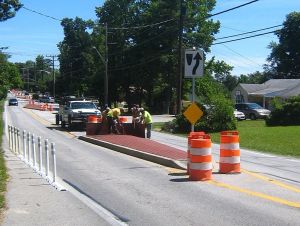Investing in Infrastructure is Key for Maryland’s Economy
Maryland is now in a good position to reverse years of decline and invest in state-of-the-art school facilities; up-to-date water treatment plants; and better highways, railroads, and ports. By stepping up these much-needed investments now, Maryland would create immediate job opportunities and support economic growth.
As federal infrastructure investment has fallen by half as a share of GDP over the last 35 years Maryland has not stepped up to task of investing in its needs. In 2013, Maryland had the fourth-lowest allocation of state and local capital spending as a percentage of its economy in the country, according to a new report from the Center on Budget and Policy Priorities. In addition, from 2002 to 2013 Maryland’s percentage of state spending on infrastructure declined more than in 41 other states. Restoring Maryland’s state and local government investments in infrastructure to 2002 levels as a share of the economy would require $2.3 billion.
So far, it seems that this trend may continue under Gov. Larry Hogan, who has insisted on capping borrowing at $900 million a year, an arbitrary figure that doesn’t take into account inflation or the state’s needs. While the state could use cash payments to make up some of the difference, doing so would mean Maryland wouldn’t take full advantage of today’s historically low interest rates. And, it’s important to keep in mind that cutting back on other critical state investments to invest more in infrastructure would eliminate many of the benefits to the economy.
Reversing Maryland’s declining investment in infrastructure would promote economic recovery. Investment in infrastructure boosts employment as soon as building begins, with large public construction projects generating hundreds of well-paying jobs. While many of the new jobs last only as long as the project is being constructed – which for major projects can mean many years – other positions will be needed to maintain the structures once they have been built, extending the project’s job-creation impact. The jobs created, mainly in fields like construction, tend to pay wages at a level that would boost the standard of living for many hard-working Marylanders.
Research demonstrates that infrastructure investments not only result in a more productive economy and higher wages but also a better quality of life for residents. Public investment in infrastructure ensures that people neighborhoods can rely on safe school buildings and up-to-code water pipes, no matter what their income or where they live. It’s is up to government at all levels to improve infrastructure and ensure that it benefits everyone.
One example of Maryland’s declining public investment is its more than 300 structurally deficient bridges. In its most recent report card on the condition of America’s infrastructure, the American Society of Civil Engineers gave the state of Maryland’s infrastructure only a C- rating. The report found that Maryland’s infrastructure is hampered by delayed maintenance and insufficient funding. “Maryland’s infrastructure faces some very real problems that threaten the way of life of our citizens and visitors if they are not addressed,” the ASCE report warns.
Policymakers should take advantage of the opportunity Maryland has now, with recent positive news on state revenues, to catch up on the projects that have been delayed in the years following the Great Recession. Doing so would create jobs and provide benefits to the state’s economy for years to come.

